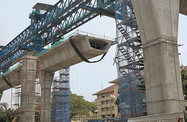Urban transportation networks in the Philippines will benefit from millions of dollars in investment, following the announcement that Cebu City will be home to a new bus rapid transit (BRT) system. The network is expected to alleviate metro congestion and offer opportunities for private contractors and service providers.
It is one of several urban mass transit projects under way, following an earlier announcement by President Benigno Aquino III of plans for new BRT and underground rail systems in Manila.
While these systems will go a long way towards solving long-term transportation challenges, short-term solutions for Manila’s existing metro rail transit (MRT) and light rail transit (LRT) systems are urgently needed. With a number of key contract awards delayed, stakeholders stress that without timely progress, existing train networks could face shutdowns, exacerbating congestion that has cost the country up to 2% of GDP in previous years.
Public and private collaboration
On September 26, the World Bank approved a loan of $141m for a planned 23-km BRT system in Cebu City to improve transport links from metro centres to outlying suburbs. The Cebu BRT system is expected to carry 330,000 passengers each day and include dedicated lanes for buses, as well as offering a lower build cost than LRT systems. The project will receive a $116m World Bank facility and a $25m loan from the Clean Technology Fund. The government will finance the remaining $87.5m of project costs.
The BRT system is expected to be financially sustainable over the duration of its life, according to the World Bank. Total recurring costs stand at around $19.9m annually, revenues from bus fares and transit advertising will reach an estimated $20.5m per year, of which 92% will be derived from fares. A detailed economic analysis found that savings in travel time, reductions in vehicle operating costs, and quantified external benefits, including greenhouse gas reductions and traffic accident reductions, will deliver an economic rate of return of 39% over 30 years.
Private sector involvement is an important component of the Cebu BRT project. Under the agreement signed with the World Bank, the Philippines’ Department of Transportation and Communications (DTC) is expected to sign a deal with a BRT systems manager that will be responsible for overseeing the system, including human resources procurement and revenue collection.
Private operators will provide bus services and be paid on both a “per kilometre” and “availability” basis, which will ensure service irrespective of demand. All other support and maintenance services will be administered by private sector suppliers, according to the World Bank. The BRT is expected to become operational in 2018.
New developments for Manila
The Cebu BRT system is the first of many major transportation projects under development. In March, the DTC announced plans to build a P4.65bn ($103.23m) BRT system in Manila, as well as a P135bn ($2.99bn) subway line, the first-ever to be built in the country. This follows a February announcement that the government intends to invest P2.3trn ($51.1bn) in transportation infrastructure.
New transportation offerings are sorely needed. In its 2013 Cebu BRT project appraisal, the World Bank reported that cities in the Philippines have been unable to keep pace with explosive urban population growth, resulting in infrastructure and housing deficiencies, traffic congestion, and pollution. Traffic, for example, has had a large economic and environmental impact. In 2008 congestion in Metro Manila cost the economy roughly 2% of GDP, according to the World Bank, and greenhouse emissions are projected to more than triple by 2030.
Short-term upgrades needed
These projects offer significant long-term solutions to congestion in Manila, but in the short-term, problems with upgrades to the city’s existing MRT and LRT systems pose an immediate challenge to authorities and commuters.
Maintenance contracts for Manila’s MRT-3 and LRT-2 lines are among over P10bn ($222.67m) in projects under development by the DTC to build new lines, improve operations and decongest traffic, but the government has so far struggled to award these contracts. Service on the lines has been characterised by technical glitches, delays and system failures.
The 16.9-km MRT system was completed in 2000, offering a design capacity of 350,000 passengers per day, although authorities estimate that it now serves approximately 540,000 passengers daily, operating at 155% capacity. Maintenance contracts for this line, as well as the government’s LRT-2 line, have each been delayed three times, most recently in October 2014.
These delays led Transportation Secretary Joseph Emilio Abayato to speculate that the MRT-3 line could face a shutdown if maintenance works, including procurement of new rail lines, are not completed, which would require up to 100 additional buses to transport the line’s passengers.

